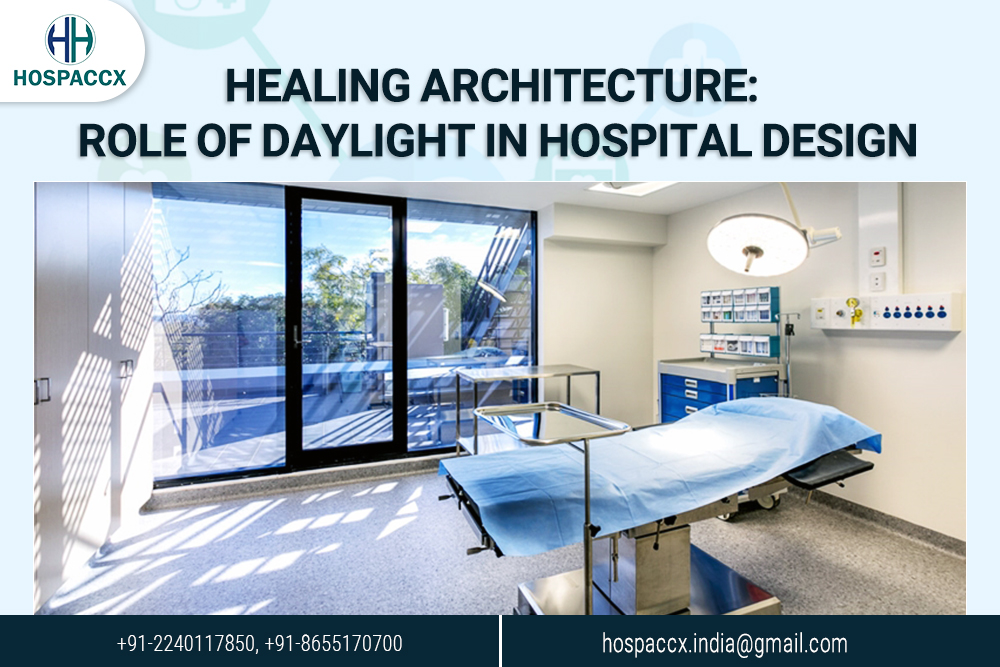Introduction
Healing environment should be the aim of designing a hospital. For this, it is an imperative for the physical aspects to be considered in hospital buildings. The physical aspects (i.e. day-lighting, window design, thermal conditions and others) should be cleverly designed to achieve the balance and the principles of economic, social and ecological sustainability without compromising the functionality of hospital building. This blog emphasizes two important aspects that lead to sustainability in hospital design: The importance of daylight to achieve a healing environment and the impact of day-lighting on health outcomes.
Considering the above facts, Hospaccx team participates in creating healing architecture of hospital with daylight consideration. This is macroficial study of ‘Healing Architecture: Role of Daylight in Hospital Design’ if you want to get into more detail you can contact info@hospaccxconsulting.com
In hospital buildings, where patients seek medical treatment and staff provides continuous support, creating a healing environment with appropriate physical aspects is an imperative to sustainable design. The aspects of healing environment in hospital design are primarily important and relevant within the context of sustainability in healthcare facilities. The term ‘Healing Architecture’ is adopted to invoke a sense of a continuous process; in creating an environment physically healthy and psychologically appropriate. A healing environment with appropriate physical aspects would indirectly contribute to patients’ outcome such as shorter length of stay, reduced stress, increased patients satisfaction.
One may agree to the idea that sustainable hospital design in the form of healing environment is achieved if these measurable outcomes could be quantified through appropriate design of physical aspects.
Creating a healing environment is not like building up a garage workshop, where cars are sent for repairs before continuing their journey. It is an imperative for a hospital environment however, where ‘repair’ of the body (i.e. healing) is the concern, to have the optimum level of comfort and care physically, socially and symbolically. For this the luminous environment plays an important role and an integral part of the hospital’s healing environment. As a matter of the fact, natural daylight is often regarded as part of the healthy environment. Therefore, daylight is required in most areas in hospital buildings and is one of the crucial physical aspects to be considered in the healing environment. In the hospital wards indoor environment, appropriate window design would allow the potential benefit of daylight to be experienced by patients and staff.
healing architecture in hospital design
Daylight has significant effects on the well-being of humans both physically and psychologically. Access to natural light is one of the crucial factors affecting patients’ recovery. The presence of visible light in an indoor environment does influence the physiological responses, mood as well as visual needs. Most psychiatrists generally agree that seasonal affective disorder (SAD) with symptoms of depression; fatigue and irritability may be triggered by shorter hours of exposure to daylight due to the seasonal change.
Lighting Strategies:
Research evidence by means of observations and qualitative analyses has found that lighting strategies (i.e. combination of daylight and artificial light) in a controlled environment have a positive impact on managing behavioral disturbances of the Alzheimer’s type. Appropriate balance of daylight and artificial light may positively affect for Alzheimer’s patients. Therefore, related issues with regard to good lighting design in the hospital wards should be taken to task seriously. Issues which are crucial factors in achieving a healing environment would include glare control, flickering-free lighting, orientation of the light to the visual task, colour rendering and temperature, and balance between electric and daylight.
Access to daylight not only has a positive impact on patients’ outcomes, it can also provide restorative benefits to other users in their respective environments such as medical staff, school children and office workers. Improved physical environment has a significant influence on the nurses’ performance in their work and has positive impact on their recruitment and retention. Absence of daylight may influence children’s performance and eventually have an impact on annual body growth and sick leave.
For this reason daylight in hospital design should rigorously be pursued as one of the physical aspects in creating a healing environment. Daylight should be incorporated into lighting design in hospital buildings, not only because it is beneficial to patients and staff, but also because it is light delivered at no cost. Adopting and implementing good daylighting will obviate the need for artificial lighting, subsequently lead for energy conservation, contributing to sustainability.
Windows:
Windows in all hospital buildings should be specified as tinted glass with various degree of darkness: dark tinted for SH-1 building, blue tinted for SH-2 building and light dark tinted for SIH building. The connection to the outside world with tinted windows may not be an issue to patients but it may affect their judgments on outside weather. Nonetheless, it can be observed that tinted windows help to reduce the brightness of outdoor sunlight.
Conclusion
Achieving sustainable hospital design with consideration of daylight is not an impossible task. In the context of hospital buildings, the measurable patients’ health outcomes in a healing environment are indirectly the result of appropriate design of physical aspects. Thus, the role of day lighting as one of the physical aspects having a significant impact on the well-being of the patients, staff and visitors. It is without doubt that well designed day lighting will obviate the need for artificial lighting. The effort to reduce dependency on artificial lighting would directly contribute to the energy consumption of hospital buildings, subsequently assisting sustainability.
Creating a healing environment with appropriate design of physical aspects (i.e. day lighting) in hospital buildings should be rigorously pursued. Professionals in the healthcare services should be inspired with the availability of natural environment (i.e. daylight and natural view) without sacrificing clinical functionality and design visions. One must accept the fact that the subject of healing is a multidisciplinary discipline. Thus, a coordinated effort by healthcare professionals and others (psychologist and lighting specialist) will be able to achieve a better hospital building not only for healing environment that is physically healthy and psychologically appropriate but also for aiming to contribute sustainable design.
Are you planning to build hospital in consideration with daylight? We can help you to design your dream project, below are the healthcare design services that we offer:-
Best Healthcare Architecture Design Consulting in India
- Healthcare Architecture Design services
- MEP Design
- Landscape Design services
- Structural Design services
- Interior Design services
It is the superficial and macro level study for more details kindly contact Hospaccx Healthcare business consulting Pvt. ltd on info@hospaccxconsulting.com or hospaccx.india@gmail.com or you can visit our website.
Related Team Members
Related Services
Other Industries
Related Blog
Related Success Stories





















